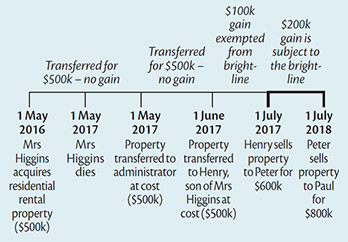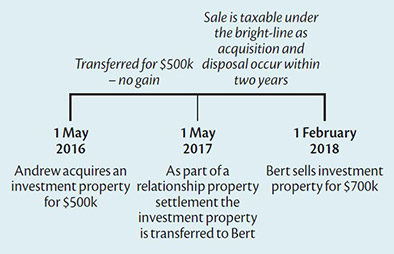Taxation (Bright-Line Test for Residential Land) Act 2015
2015 Act introduces a 'bright-line' test requiring income tax to be paid on any gains from residential property that is disposed of within two years of acquisition.
Sections CB 6A, CB 13, CB 14, CB 15B, CB 16A, CB 23B, DB 18A, DB 18AB, DB 29, FB 3A, FC 3, FC 4, FC 9, FO 10, FO 17, GB 52, GB 53, and YA 1 of the Income Tax Act 2007; sections 3 and 43B of the Tax Administration Act 1994
The Taxation (Bright-line Test for Residential Land) Bill was introduced into Parliament on 24 August 2015. The bill received its first reading on 8 September 2015, the second reading on 3 November 2015 and the third reading on 12 November 2015. The resulting Act received Royal assent on 16 November 2015.
The Taxation (Bright-line Test for Residential Land) Act 2015 introduces a new "bright-line" test that will require income tax to be paid on any gains from residential property that is disposed of within two years of acquisition, subject to some exceptions.
The new legislation amends the Income Tax Act 2007 and the Tax Administration Act 1994.
Background
As part of Budget 2015, the Government announced its intention to introduce a new land sale rule to supplement the "intention test" in the land sale rules. Under those rules, gains from the sale of land are taxable when the land is bought with an intention or purpose of resale, and the taxpayer is required to return any gain as income. Because of the subjective nature of the intention test however, it can be difficult to enforce. To deal with this problem, the new legislation introduces a new easy-to-enforce bright-line test.
The bright-line test is the second of three stages of the Government's reform package to tighten the property investment rules announced as part of Budget 2015.
The first stage - new information requirements for land transfers and offshore persons - came into force on 1 October 2015, and information about the new rules was published in the November edition of the Tax Information Bulletin (Vol 27, No 10, November 2015).
The third stage - a withholding tax for offshore persons selling New Zealand residential property - was introduced into Parliament on 16 November 2015 in the Taxation (Residential Land Withholding Tax, GST on Online Services, and Student Loans) Bill, following consultation in August 2015.
Key features
Gains from the disposal of residential land acquired and disposed of within two years will be taxable, subject to some exceptions.
The two year bright-line period generally starts at the point a person has title for the property transferred to them and ends at the time the person enters into a contract to sell the property. For sales "off the plan", the two-year period runs from the date the person enters into a contract to buy the property to the time when a person enters into a contract to sell the property.
The bright-line test applies only to residential land. Residential land includes land that has a dwelling on it, land where the owner has an arrangement to build a dwelling on it, and bare land that could have a dwelling erected on it under the relevant district plan. "Residential land" does not include business premises or farmland.
The bright-line test does not apply to a person's main home. A person can only have one main home. If a person has more than one home, their main home is the one with which the person has the greatest connection.
The main home exclusion is generally available to properties held in trust. There are additional requirements to ensure that people cannot use the main home exclusion for multiple properties through the use of trusts.
The bright-line test does not apply to property acquired through an inheritance. There is rollover relief for property transferred as a result of a relationship property agreement. This means that any potential tax liability will be deferred until a subsequent sale.
Taxpayers will be allowed deductions according to ordinary tax rules for property that is subject to the bright-line test.
Losses arising from the bright-line test will be ring-fenced so that they may only be used to offset taxable gains from other land sales.
There are specific anti-avoidance rules to counter companies and trusts being used to circumvent the bright-line test.
Application dates
The bright-line test came into force on 1 October 2015.
The bright-line test will only apply to a person's disposal of land if the person acquires their "first interest" in the land on or after 1 October 2015. The date a person acquires their "first interest" is the same date as when they acquire land for the purposes of section CB 15B in the Income Tax Act 2007. As a result, guidance on section CB 15B can be used to help determine when a person's "first interest" in land was acquired.
When there is a standard acquisition of land, the date a person acquires their "first interest" will generally be the date of entry into an agreement to purchase the land. This means the bright-line test will only apply to the sale of land if the agreement for purchase of the land was entered into on or after 1 October 2015.
Example: Application date
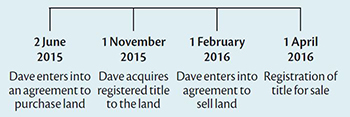
The sale by Dave is not subject to the bright-line test. This is because Dave acquired his "first interest" in the land when he entered into an agreement to purchase the land on 2 June 2015. As this is before 1 October 2015, the bright-line test does not apply.
For non-standard sales of land, the date of "first interest" may be different for different circumstances. For example, for a gift, the date of "first interest" will usually be the date of registration of title.
The amendments for the non-active trust filing exception came into force on 16 November 2015.
The amendments for the definition of "land", and clarifying the treatment of land transferred under a resident's restricted amalgamation came into force on 1 October 2015.
DETAILED ANALYSIS
Two-year time period
Section CB 6A of the Income Tax Act 2007
Under the bright-line test any gain a person derives from disposing of residential land is treated as income of the person if the property is disposed of within two years of acquisition.
The start and end date for the purposes of this two-year period are specifically defined for the purposes of the bright-line test. Start and end dates for different transactions may differ depending on the nature of the transaction.
Standard sales of land
There are four steps in the land sale process of relevance to the bright-line test:

For standard sales of land, the start date for the bright-line period is the date the transfer of the land is registered to the person under the Land Transfer Act 1952. The end date is the date that a person enters into an agreement to dispose of the land.
There are a number of situations when land is acquired and disposed of that do not follow the standard land sale process. For these situations, there are separate rules for when the bright-line period starts and ends.
Start dates
| Type of acquisition | Start date of bright-line test |
|---|---|
| Standard purchase of land | Registration |
| Sales when there is no registration of title | Latest date property acquired (according to ordinary rules) |
| Sales "off the plan" (as outlined in the section below) | Date of entry into a contract to purchase |
| Subdivided land | The original date of registration for the undivided land |
| Converting a lease with a perpetual right of renewal into freehold title | Date the lease with a perpetual right of renewal is acquired |
Sale when there is no registration of title
When there is registration of title, generally the start date for the bright-line is the date of registration. However, there are situations when there is no registration of title. In these circumstances, the start date for the bright-line test is the latest date the person acquired the land under ordinary rules.
For a sale of a contract to buy land, this will be the date that a person enters into a contract to purchase the property. This means that for a sale of a contract to buy, the bright-line period runs from the date that a person enters into a contract to purchase the land to the date that a person enters into a contract to sell the land.
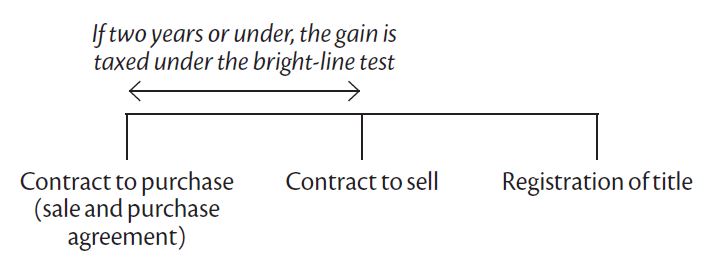
Earlier start dates than given under standard rules
There are three specific scenarios where a person is entitled to an earlier start date than would be the case under the two rules outlined above. These are for:
- sales "off the plan";
- subdivided land; and
- leases with a perpetual right of renewal converted into freehold title.
Sales "off the plan"
A sale "off the plan" for the bright-line test occurs when a person enters into a contract to acquire a parcel of land that is being developed or subdivided. At the time the person enters into the contract, the title for the land they are agreeing to purchase does not yet exist (as the land needs to be subdivided or developed before separate title can be issued). The person agrees to acquire registered title in the land once a separate title exists.
In this situation, the person may use an earlier start date than would be the case under the standard rule. The start date in this situation is the date the person enters into an agreement for the sale and purchase of the land.
Example: Sale "off the plan"
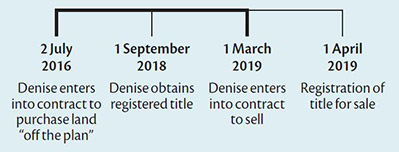
Denise is not subject to the bright-line test as the start date for the bright-line is 1 July 2016 (the date she entered into a contract to purchase "off the plan") and the end date is 1 March 2019 (the date she entered into a contract to sell).
Subdivided land
The start date for the bright-line period when land is subdivided is the date the owner originally acquired the undivided land.
Example: Subdivision
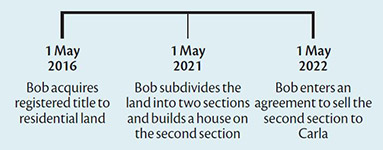
The start date for the bright-line period is 1 May 2016 and the end date is 1 May 2022. As a result, Bob's sale of the second section to Carla is not covered by the bright-line test.
Conversion of a lease with a perpetual right of renewal into freehold title
When a person has a lease with a perpetual right of renewal which they then convert into freehold land, the start date for the bright-line period is the date the person is granted the lease. This is consistent with other tax provisions that treat a lease with a perpetual right of renewal similar to freehold estates.
Example: Lease with perpetual right of renewal
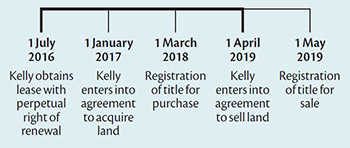
The start date for Kelly's bright-line period is 1 July 2016 (the date the lease with perpetual right of renewal is granted) and the end date is 1 April 2019 (the date she entered into agreement to sell the land).
Gains from Kelly's sale of the land are not taxable under the bright-line test.
End date for bright-line period
For standard sales of land the end date for the bright-line period is the date a person enters into an agreement to dispose of the property.
There are several situations when land is disposed of but there is no agreement in place to dispose of the property. In these situations, the proposed end date for the bright-line period differs from the standard rule.
| Type of disposal | End date of bright-line period |
|---|---|
| Standard purchase of land | Date of entry into agreement for sale |
| Gift | Date of gift (generally registration of title) |
| Compulsory acquisition | Date of compulsory acquisition |
| Mortgagee sale | Date land disposed of by mortgagee |
| Other disposals where no contract to sell | Date of disposal according to ordinary rules |
Gifts
For gifts, the end date for the bright-line period is the date the person makes the gift of the residential land. This will be the date when the donor has done everything necessary in order to transfer the property and render the settlement binding.
For a gift of a registerable interest in land, this will mean the end date for the bright-line period is the date the interest is registered.
Example: Gift
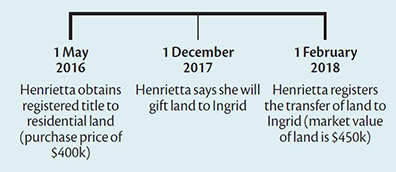
The start date for the bright-line period is 1 May 2016 (the date Henrietta acquired registered title) and the end date is 1 February 2018 (the date Ingrid acquired registered title). Henrietta will be subject to the bright-line test for her gift of land.
Under ordinary tax rules, gifts of land are treated as if they are transferred at market value.
As a result, Henrietta will be deemed to have transferred the land to Ingrid at market value and the $50k gain will be taxable.
Compulsory acquisition
When the land is compulsorily acquired by the Crown, the end date of the bright-line period is the date that the land is compulsorily acquired. This will generally be 14 days after the proclamation that the land is to be acquired, is published in the Gazette.1
Mortgagee sale
When land is disposed of by a mortgagee exercising their right to dispose of the property, the end date for the bright-line period is the date when the land is disposed of by the mortgagee.
Other sales
If there is another type of disposal of land, the date of disposal is the date that the land is disposed of according to ordinary rules.
Example: Standard sale
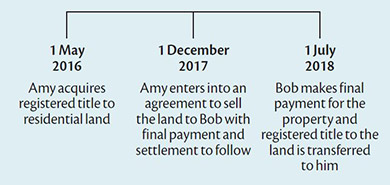
The bright-line period starts on 1 May 2016 (the date registered title is acquired) and ends on 1 December 2017 (the date of entry into agreement to sell the land).
Amy receives payment for the property in the 2018–19 income year. This means that Amy is required to return the income in her annual income tax return for the year.
Example: Cancelled contract
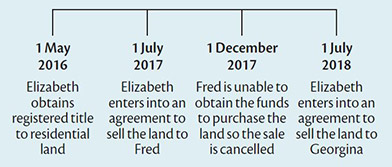
The sale of the land from Elizabeth to Fred falls within the two-year period for the bright-line test. However, because the sale is cancelled, Elizabeth has not derived any income from the disposal of land and will not have any income tax liability.
The sale of the land from Elizabeth to Georgina is not subject to the bright-line test because the agreement for sale (1 July 2018) was not entered into within two years of Elizabeth obtaining registered title (1 May 2016).
Example: Standard lease (no perpetual right of renewal)
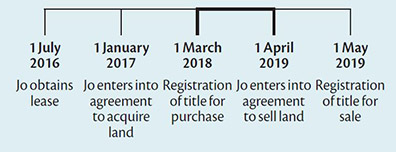
The start date for the bright-line test is 1 March 2018 (the date of registration of title for purchase) and the end date is 1 April 2019 (the date she entered into agreement to sell the land). Jo's proceeds from the sale of the land are taxable under the bright-line test.
Example: Deed of nomination2
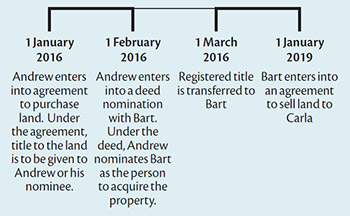
With a nomination there are two acquisitions and disposals of land.
Andrew acquired an interest in the land by entering into a contract to purchase on 1 January 2016 (the date he acquired the right to buy the land). When Andrew entered into a deed of nomination with Bart he transferred this interest (the right to buy the land) to Bart.
The start date for Andrew is the date he entered into the contract to purchase the land. This is because it is a sale where there is no registration. The start date is the latest date Andrew acquired an interest in the residential land. The latest date Andrew acquired an interest in the residential land is 1 January 2016 when he acquired his right to buy.
The end date for Andrew is 1 February 2016, being the date he entered into an agreement for the disposal of his interest in the land. The deed of nomination is an agreement for the disposal of the land.
As a result, Andrew is subject to the bright-line test and any gain he has made will be taxable.
Bart's acquisition and disposal of the land will not be covered by the bright-line test. This is because the start date was on 1 March 2016 (date of registration of title) and the end date was 1 January 2019 (the date he entered into agreement to sell).
Residential land
Sections CB 6A and YA 1 of the Income Tax Act 2007
The bright-line test only applies if the land disposed of is residential land at the date of disposal.
"Residential land" is land that either:
- has a dwelling on it;
- the seller of the land is a party to an arrangement that relates to erecting a dwelling on it; or
- is bare land that may be used for erecting a dwelling under the rules in the relevant operative district plan.
However, even if one of these three criteria is met, land is not treated as "residential land" if it is used predominantly as business premises or is farmland (as discussed below).
Dwelling
The first criterion includes land that has a dwelling on it. The definition of "dwelling" is the same as that currently used in the Income Tax Act 2007 and the Goods and Services Tax Act 1985. However, there are two adjustments to the definition of "dwelling" for the purposes of the bright-line test. The first adjustment includes serviced apartments within the definition of "residential land", while the second excludes all rest homes and retirement villages from the definition.
The second criterion means that the bright-line test covers land that does not have a dwelling on it at present but there is a plan or understanding to build a dwelling on it. For example, this criterion would apply when the owner of a commercial office has an arrangement to convert it into dwellings.
The third criterion means the bright-line test covers bare land that could be used for a dwelling. To determine whether a parcel of bare land meets this criterion, a person will need to look at the relevant rule in the operative district plan to see whether they are able to build a dwelling on it.
Example: Development
Andrew buys an empty plot of land that is zoned for residential purposes. He plans to develop the plot by subdividing it into four lots and building houses on each of the lots.
Andrew sells lot 1 "off the plan" to Bob. One month later, Bob sells lot 1 to Carla.
Lot 1 would be "residential land" and Bob's sale would be subject to the bright-line test. This is because there is an arrangement to build a dwelling on the land, and because it is bare land that can have a dwelling erected on it under the relevant district plan.
Business premises
"Residential land" does not include land used predominantly as business premises.
"Business premises" has its ordinary meaning under the Income Tax Act 2007. This will generally require there to be a building on the land, and this building to be occupied by a person in the course of running their business.
The exemption does not require that the land be occupied by the owner as their business premises. As a result, properties rented out by the owner to other persons to use as their business premises are also covered by this exemption. However, the exemption would not apply when a property is rented out for residential purposes (such as a residential rental property).
Example: Bed and breakfast
Mary owns a bed and breakfast. Mary provides meals to the residents, room service and cleans the rooms she lets out every day.
The land has a dwelling on it so meets the first criterion for residential land. However, the land would not be "residential land" as the land is used predominantly as the business premises for the bed and breakfast.
Example: Workers' quarters
Steve owns land which contains a factory which is used to process food. The land also has workers' quarters on it, which Steve provides to his employees to use as residences.
The land is used predominantly as business premises and so is entitled to the business premises exception.
Example: Empty factory
Velma purchases an empty factory which she plans to develop into an apartment building.
Before beginning construction, and within two years of her acquisition, Velma receives a good offer for the building and sells it to William.
Velma has an arrangement to put a dwelling on the land and so meets the first criterion for residential land. The land does not qualify for the business premises exemption as the factory is empty and not being used as business premises at the time of disposal. As a result, the land is "residential land" and subject to the bright-line test.
Farmland
"Residential land" does not include farmland.
"Farmland" means land that either:
- is being worked on as part of a farming or agricultural business by the owner of the land; or
- because of its area and nature, is capable of being worked as a farming or agricultural business.
Determining whether there is a farming or agricultural business on the land requires looking at the same factors that determine whether there is "a business" under general tax law. This requires looking at the nature of the activities carried on and the intention of the taxpayer in undertaking the activities.
Even if there is no farming business being run on the land, it can still be considered "farmland" if the land is capable of being worked as a farming or agricultural business. Determining whether land is capable of being worked requires looking at the capability of the land at the time of the disposal. Land that requires significant investment or modification to be used as a farming business would therefore not qualify.
Example: Land that because of its area is not capable of being used as farmland
Marama purchases a lifestyle block with a house and a small area of farmland. A small number of sheep are kept on the land to keep the grass down.
The land is not "farmland" as the land is not being worked as a farming business nor is it capable of being worked as a farming business. It is a hobby farm rather than a genuine farming business.
If the area of farmland was larger and capable of being used for farming purposes, it would likely be "farmland".
Example: Land that because of its nature is not capable of being used as farmland
Tina owns a 50 hectare plot of land. The land is covered in gorse.
The land is not "farmland" as it is not currently capable of being used for farming purposes.
Example: Small plot of land that is farmland
Uri has a five hectare plot of land that is suitable for use as a rose farm.
This land is "farmland" as it is currently capable of being used for farming purposes.
Main home
Sections CB 16A and YA 1 of the Income Tax Act 2007
The bright-line test does not apply to the disposal of a person's main home.
Requirements for the "main home" exclusion
To qualify for the "main home" exclusion the land must have been used predominantly, for most of the time the person owned the land, for a dwelling that was the main home of the person or a beneficiary of a trust that owned the property (subject to some limitations).
Used predominantly as a person's main home
To be used predominantly as a "main home", means that most of the area of the land must have been actually used for the home. The test is based on a person's actual use of the property and not the person's intended use of the property.
In some circumstances, a person will be required to determine the area of land used for their private residential purposes and the area of land used for other purposes. For example, when a single property has been used by the owner partly as a residential home and partly as a rental property, the relative areas will need to be determined. In many cases, a taxpayer will have determined the relative areas in working out the tax deductions (insurance and rates, for example) that can be claimed. The determination of the areas includes any land used for the relevant purposes (for example, a backyard or garage for the home).
The main home exclusion can only apply when the property is actually used as the main home. The exclusion can only apply in full or not at all; it does not apply on a proportionate basis. As a result, if a property is used less than 50 percent of the time as the main home of the person, the main home exclusion will not apply.
Used for most of the time as their main home
The land must have been used for most of the time that the person owns the land as their main home. This requires the property to have been used more than 50 percent of the time as their main home for the period the person owns the land. The land does not need to have been used without interruption as their main home. For example, a main home can be rented out for short periods while the owner is on holiday or before settlement of the sale of the property, as long as the time is less than the private residential use.
The owner must have resided in the property as their main home. The main home exclusion will not apply when only a family member and not the owner has used the property as their main home.
More than one home
A person can only have one main home. When a person has two houses that they reside in, the property that is their main home is determined according to which property the person has the greatest connection with. The "greatest connection" test operates only as a tie-breaker when a person has more than one home.
The greatest connection test determines, on an objective basis, which property is the person's main home. The test does not allow a person to elect their main home. Various factors may be relevant in determining which property the person has the greatest connection with, including:
- the time the person occupies the dwelling;
- where their immediate family (if any) live;
- where their social ties are strongest;
- the person's use of the dwelling;
- the person's employment, business interests and economic ties to the area where the dwelling is located; and
- whether the person's personal property is in the dwelling.
These factors are similar to those used to determine if a person has a "permanent place of abode" under current tax law. Therefore, existing guidance on the "permanent place of abode" test could assist in determining which property the person has the greatest connection with.
Using the "main home" exclusion for two properties
Under limited circumstances, a person may use the main home exclusion for two properties sold at the same time.
An example is when a person lives in a home for less than one year as their main home, and moves into a new home while trying to sell the original home. The original home may satisfy the requirements to be the person's main home (as discussed above) for the period before moving into the main home. The new home may also satisfy the requirements to be the person's main home for the subsequent period.
The ownership overlap of the properties will not mean the original home fails to satisfy the requirements to be a main home for the previous period. If the two properties were sold at the same time, the owner would be able to use the main home exclusion for both properties (if they both satisfied the requirements to be a main home for the different periods).
Example: Main home exception for multiple properties
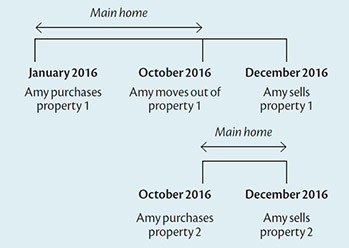
The main home exclusion is available for both of Amy's properties. Property 1 was the main home for 9 out of the 11 months that Amy owned the property. Property 2 was the main home for the entire time Amy owned it.
Different owners can have different main homes
Co-owners of property can have different main homes. For example, a person living in one city may have a different main home from their spouse living in another city. The bright-line test will only apply to the extent the property is not the main home of an owner on disposal.
Habitual sellers
A person who habitually sells their main home cannot use the main home exclusion.
A person is considered a habitual seller if they either:
- previously used the main home exclusion twice in the previous two years from the date the property is disposed of; or
- have engaged in a regular pattern of acquiring and disposing of residential land.
If either of these apply, the main home exclusion is not available for this person.
Determining whether there is a regular pattern is a question of fact and degree. Examining transactions that occurred before the disposal of the property in question can help to establish whether the seller has a regular pattern of similar transactions.
Main home and trusts
The trustee of a trust can generally use the main home exclusion if they dispose of a property that is the main home of a beneficiary of the trust. To obtain the exception the land must be used predominantly as the beneficiary's main home for most of the time the trust owns the land.
A trust cannot use the main home exclusion when a principal settlor of the trust has another main home. This rule is to ensure that people cannot get the main home exclusion multiple times through the use of a trust.
Who is a principal settlor?
A principal settlor is the person who has provided the most value to the trust (by market value).
For the purposes of determining a principal settlor, all provisions of value are counted except for the provision of services at below market value. If there are multiple people who have provided the greatest equal value to the trust, they are all considered principal settlors.
In addition, a person is not a principal settlor if they have provided a "no-strings attached" gift to the trust. This means that for the purposes of determining who has provided the most value to the trust, provisions of value transferred by a person if the person is none of the following are disregarded:
- a beneficiary;
- a trustee;
- a person with the power of appointment or removal of trustees;
- a person with a contingent interest in the trust property, in the case that the trust fails; or
- a decision-maker under the trust.
Example: Holiday home
Lisa rents an apartment in Wellington, where she lives with her son. The apartment is close to her office from which she runs her consulting business fulltime. She is a member of a local tramping club and is on the Board of Trustees of her son's school in central Wellington.
She owns a house on Lake Taupo with views over the lake. She does not let the Lake Taupo property out when she is not using it. She spends four weeks with her son in this property over Christmas and New Year, and also uses the property for about five weekends during the ski season.
When Lisa sells the Lake Taupo property, she cannot use the main home exclusion because it is not the property with which she has the greatest connection.
Example: Multiple dwellings
Bill buys an apartment block on a single title. He lives in one of the apartments as his main home and rents out the remaining six apartments. Bill sells the apartment block to a third party.
Bill cannot use the main home exclusion because the land (contained on the single title) was not used predominantly as his main home. The majority of the land was used as rental property.
Example: Two properties
Mr and Mrs Brown and their children live in a house on a small lifestyle block in Oamaru. Mrs Brown works in Christchurch for three days a week, and works from the Oamaru house two days a week while her husband looks after the children fulltime. Mrs Brown buys an apartment in Christchurch city. She lives in that apartment while she works in Christchurch.
Taking into account the fact that the majority of Mrs Brown's time is spent at the Oamaru house, and her family is located at the Oamaru house, the main home exclusion will not apply in relation to Mrs Brown's Christchurch apartment as it is not the home with which she has the greatest connection.
Example: Country store and house
Barbara buys a country store that has living quarters attached. She resides in the living quarters and runs a retail business from the front half of the property. She estimates that the retail business uses 45 percent of the property and claims expenses (insurance and rates) on that basis against the retail income. Barbara sells the property.
Barbara is not able to use the business premises exception as the land is not used predominantly for her retail business (45 percent).
However, Barbara can use the main home exclusion because she has used the property predominantly (55 percent) as her main home during the time she has owned the property. She uses her previous estimate for her expenses to prove her actual use of the property.
Example: Non-resident
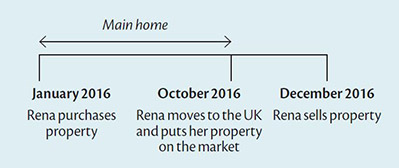
Rena is entitled to the main home exclusion. This is because she has used the property as her main home for the majority of the time she has owned it.
Example: Trusts - student flat
Dave has two properties, a family home which he lives in, and a student flat which his son lives in while studying. Dave settles the student flat on a trust and makes his son a discretionary beneficiary of the trust.
The trust cannot use the main home exclusion because the principal settlor of the trust (Dave) has another main home.
Inheritance
Sections CB 6A(3) and FC 9 of the Income Tax Act 2007
When a person dies, their property may be sold or transferred to a beneficiary, who may subsequently sell the property. These transfers and disposals will not be subject to tax under the bright-line test.
How property is transferred through an inheritance
When a taxpayer dies, an estate can be dealt with in several ways, depending on whether a will exists. A will usually provides for the appointment of one or more executors. In the absence of a will, a court will appoint someone to administer the deceased's estate.
The executor or administrator is vested with legal and beneficial ownership of the deceased's property from the time of death to the end of the period of executorship or administration. The beneficiaries have a right to have the deceased's estate administered properly during this period but do not have a legal or beneficial interest in the assets.
The duties of the executor or administrator are to collect the assets of the deceased, pay all debts, testamentary expenses and taxes and to distribute the legacies. At the end of the period of executorship or administration, the executor or administrator becomes a trustee of the residual assets on behalf of the beneficiaries.
Property that has been bequeathed or devised under a will may be gifted as a specific legacy, general legacy or residuary gift. Specific legacies are treated as taking effect from the date of transfer to take effect from the date of death, so income arising from the property is derived by the beneficiary from the date of death. A general or residuary legacy vests in a beneficiary at the time of distribution.
Inheritance exception from bright-line test
The bright-line test provides rollover relief for all transfers following a death and an exemption for any disposals by the executor or administrator or subsequent disposals by the beneficiaries.
The rollover relief is achieved by treating the transfers from the deceased person to the executor or administrator, and from the executor or administrator to the beneficiary, as a disposal and acquisition of the property, at the total cost of the land to the deceased person at the date of transfer (rather than at the land's market value). The effect is that no tax liabilities under the bright-line test arise under the transfers.
Disposals by a beneficiary, executor or administrator of residential land transferred to them on the death of a person are specifically excluded from the bright-line test. However, the disposals may still be subject to tax under the current land sale rules.
Relationship property
Section FB 3A of the Income Tax Act 2007
When a relationship breaks down, property may be transferred between the spouses or partners. The property may then subsequently be sold. Transfers of property under a relationship property agreement are excluded from the bright-line test. However, any subsequent sale of the transferred property will be subject to the bright-line test.
How property is transferred under a relationship property agreement
During a marriage, civil union or de facto relationship, the parties hold any property according to the conventional laws relating to property. As a result, the parties are free to deal with their property during the relationship without regard to the provisions of the Property (Relationships) Act 1976.
When a relationship breaks down, the Property (Relationships) Act 1976 may be invoked by a court order or an agreement between the parties. When the statutory regime is invoked, new property rights operate from the date of the court order or agreement. The property of the spouses or partners is reapportioned between them under principles from the statutory regime. Each item of property is divided into one of two statutory categories:
- relationship property; or
- separate property.
The fact that a particular item of property is placed within one of these two categories then produces a prima facie result in the way it is treated as between the two spouses or partners. Prima facie, all relationship property is divided in equal shares, while separate property is retained by the owner.
Rollover for relationship property
A transfer of property under a relationship property agreement will be entitled to the current rollover relief that applies to such transfers. This will mean that no tax liability under the bright-line test arises for the transfer of the property under the relationship property agreement. However, the person to whom the relationship property has been transferred may be liable under the bright-line test for any subsequent disposal of the property. This will occur if the person receiving the relationship property enters into an agreement to dispose of the property within two years of the original registration of title for the property.
Rollover for land transferred under a resident's restricted amalgamation
Sections FO 10 and FO 17 of the Income Tax Act 2007
Under the bright-line test there is rollover relief for amalgamations. This rollover relief extends the existing rollover relief for amalgamations to property that is revenue account property of an amalgamating company due to the application of the new bright-line test.
Current amalgamation rules
The amalgamation rules in the Income Tax Act 2007 contain a rollover provision for property transferred as a result of an amalgamation.3
The rules provide that when property is held on revenue account by an amalgamating company solely due to the application of a 10-year rule in sections CB 9 to CB 11 and CB 14, the property is transferred to the amalgamated company at cost.
If the amalgamated company disposes of the property within 10 years of the original date of acquisition of the property by the amalgamating company, any gain from the sale is taxable.
Extending current rules to bright-line test
Under the bright-line rules this rollover relief is extended to property that is revenue account property of an amalgamating company due to the application of the bright-line test.
Example: Land held on revenue account solely due to bright-line test
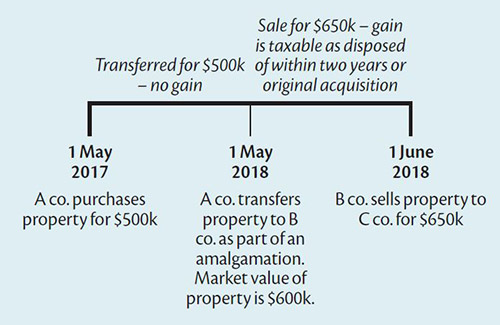
On 1 May 2018 the property is transferred from A co. to B co. at cost ($500k). A co. does not have a tax liability from the transfer as there is no gain from the disposal.
On 1 June 2018, B co. is taxable on the $150k gain from the sale. This is because B co. disposed of the property within two years of the original date of acquisition of the property by A co. (1 May 2017).
Deductions
For property that is liable for tax under the bright-line test, taxpayers will be able to deduct expenditure according to the ordinary tax rules.
The cost of the property can be deducted
A person who sells property that is subject to the bright-line test will be allowed a deduction for the cost of the property at the time of sale.
The cost of the property includes the amount that was paid to acquire the property (the initial acquisition price of the property). The cost of the property also includes any expenditure related to the acquisition. As a result, the costs of lawyers, valuers, surveyors and real estate agents are deductible. The incidental costs of disposing of the property are also deductible as part of the cost of the property. The cost of the property also includes any capital improvements to the property made after acquisition, such as renovations.
When holding costs are deductible
While a property is owned there will be periodic holding costs (of a non-capital nature) such as interest, insurance, rates and repairs, and maintenance expenses.
To be deductible as incurred, the holding costs must satisfy the normal deduction requirements. In other words, the holding costs are deductible to the extent they have a nexus with income and to the extent they are not private in nature (or otherwise subject to any of the general limitations on deductions).
A deduction will be considered to be of a private nature if it is exclusively related to living as an individual. This will be determined by the specific facts of any given situation. However, interest costs can automatically be deducted if the property is owned by a company (subject to some limitations).
For example, when the property is part of a business or profit-making undertaking or scheme, and there is no private use, it is likely that the nexus would be satisfied. Further, when the property is rented out there would likely be a nexus between the holding costs and the rental income. However, if a person purchases a bach for family use, but sells the bach within two years, the holding costs would not be deductible because of the private limitation.
Ring-fencing losses
Section DB 18A of the Income Tax Act 2007
Losses from deductions that are claimable solely against bright-line income (bright-line deductions) are ring-fenced, so they can only be offset against gains on other land sales that are taxable under any of the land sale provisions.
The amount of bright-line deductions allowed in any income year is limited to the amount of bright-line income and net land income for that year. Net land income is the amount of net income for the year as if the person's only income was derived from the disposal of land under sections CB 6 to CB 14.
Any excess deductions not allocated to the income year will be treated as the cost of revenue account property and carried forward to the next income year. However, any excess deductions will not be able to be carried forward if the general continuity requirements for carrying forward tax losses are not satisfied.
Example: Ring-fenced loss
In June 2017 Zac sells residential land that is taxable solely due to the bright-line test. Zac acquired the land for $600,000 and sold it for $540,000. For the 2017–18 income year, Zac also earned $80,000 in salary.
The $60,000 loss for the sale of residential land is ring-fenced so that it may only be used to offset income from other land sales. Zac cannot use the $60,000 loss to offset his income from salary and wages.
In August 2019 Zac sells land that he purchased with an intention of resale. Zac made a gain of $100,000 from the sale. Zac may offset his previous $60,000 loss against the $100,000 gain. As a result, Zac only has to pay tax on $40,000 of the gain in the 2019–20 income year.
Losses from transfers to associated persons
Section DB 18AB of the Income Tax Act 2007
A person cannot recognise a loss arising from a transfer of property to an associated person if that loss is taxable solely due to the bright-line test.
However, to avoid genuine losses being denied permanently, the associate may increase the cost base of the land by the amount of the denied deduction.
Example: Transfer to associate
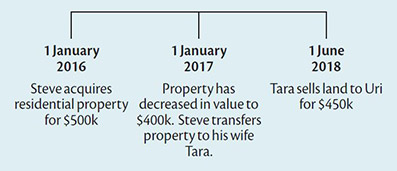
Steve's deductions are capped at $400k for the transfer on 1 January 2017. He cannot claim the $100k loss for the year.
When Tara sells the land on 1 June 2018, she can deduct $500k. This is made up of the $400k cost of acquisition as well as the $100k of denied deductions.
Land-rich companies and trusts
Sections GB 52, GB 53
To address the risk of people using land-rich companies and trusts to circumvent the bright-line test, a specific anti-avoidance rule applies.
Land-rich companies
The anti-avoidance rule for land-rich companies applies when all four of the following are met:
- The company is land-rich - this means at least 50 percent of the value of the company is attributable to residential land.
- 50 percent of the shares in the company are disposed of within a 12-month period.
- Some of the company's residential land was acquired within two years of the disposal of the shares.
- The disposal of shares had a purpose or effect of defeating the intent and application of the bright-line test.
Definition of "land-rich company"
A "land-rich" company is one where at least 50 percent of the value of the company is attributable to residential land either directly or indirectly. This is intended to mirror similar provisions contained in international double tax agreements. Residential land can be attributable to a company either through the company owning the residential land in its own name or holding shares in another land-rich company.
Deemed disposal
When the requirements are met the land-rich company is treated as disposing of residential land that it acquired within two years of the share disposal to the shareholder at cost. The amount of residential land and the price are at the cost proportional to the shareholding of the relevant shareholder.
The shareholder is then treated as immediately disposing of the residential land back to the company at market value.
Example: Land-rich company

X co. will be treated as disposing of 50 percent of the residential land to Steve for $250k.
Steve will then be treated as disposing of the residential land back to the company for $300k.
As a result, Steve will have to pay income tax on the $50k gain from the deemed sale.
Land-rich trusts
Section GB 53 treats a trustee as having disposed of residential land at market value if all three of the following apply:
- The trust is land-rich - this means that at least 50 percent of the value of the trust is attributable to residential land.
- Any of the following changes are made:
- the trust deed changes; or
- a decision-maker under the trust deed changes; or
- an arrangement under the trust changes.
- The change was made with a purpose or effect of defeating the intent and application of the bright-line test.
OTHER REMEDIAL AMENDMENTS
Non-active trust filing exception
Section 43B of the Tax Administration Act 1994
An amendment to the Tax Administration Act 1994 allows non-active trusts (which are currently required to file nil income tax returns) to apply to be exempted from the obligation to file, thereby reducing compliance costs.
Requirements for exception
Trusts that are non-active will no longer be required to file annual income tax returns if:
- throughout the tax year the trust is a non-active complying trust; and
- the trustee of the trust has filed a declaration that the trust is non-active (and the trust has not become active since making the declaration).
A trust will be non-active if it has:
- not derived or been deemed to have derived any income;
- no deductions; and
- not been a party to, or perpetuated or continued with, any transactions with assets of the trust in the tax year, which give rise to income in any person's hands, or fringe benefits to any employee or to any former employee.
Certain minimal amounts of income or deductions can be ignored in determining whether a trust is non-active. This includes:
- reasonable fees paid to professional trustees to administer the trust;
- up to $200 of bank charges or other minimal administration costs;
- up to $200 of interest earned on trust assets in a bank account during the tax year; and
- insurance, rates, and other expenditure incidental to the occupation of a dwelling owned by the trust and incurred by the beneficiaries of the trust.
The amendment sets out the process by which a non-active trust may apply for exemption from filing income tax returns. This process entails completing a declaration - first, that the trust is a non-active trust and secondly, that a trustee of the trust will inform the Commissioner if it ceases to be so. The trustees of the trust are thereby placed under a statutory obligation to inform the Commissioner upon the cessation.
The Commissioner will retain the power to request the trustees of a trust to file a return of income even if it holds an exemption under the amended provision.
The amendment is based on a similar provision for non-active companies in section 43A of the Tax Administration Act 1994.
Definition of "land"
Section YA 1 of the Income Tax Act 2007
As a result of the rewrite of income tax legislation, there was an unintended change to the definition of "land". This change created uncertainty over whether it included an interest in land.
To resolve this, the definition of "estate" and "interest" in land have been replaced with a definition of estate and interest in land that clearly includes interests in land. The definition of land clearly included an interest in land before the rewrite of the definition.
In addition, the new definition clarifies that an interest in land includes the right to possession of land.
Clarifying treatment of land transferred under a resident's restricted amalgamation
Section FO 17 of the Income Tax Act 2007
The new Act clarifies the treatment of revenue account property transferred as a result of a resident's restricted amalgamation when, at the time of the amalgamation, it is unclear whether the amalgamated company holds the property on revenue or capital account.
Current amalgamation rules
When two companies merge under an amalgamation, the transfer of assets between the companies is generally exempt from tax. However, the transfer is not exempt from tax if the property leaves the tax base.
The amalgamation rules achieve this result by transferring property either at cost or at market value, depending on whether the amalgamating and amalgamated company hold the property on revenue or capital account. This is illustrated in Table 1.
Table 1
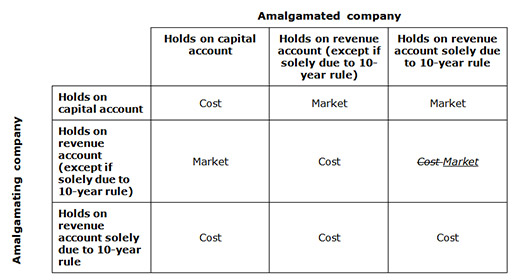
However, when the amalgamated company holds the property on revenue account, if it disposes of the property within 10 years, it is unclear for the amalgamating company whether it transfers the property at cost (and has no tax liability) or at market value (and has a tax liability).
Deemed market value transfer
The amendment applies so that property is deemed to be transferred at market value when:
- the land is held on revenue account for the amalgamating company; and
- the land is, or may be, revenue account property of the amalgamating company solely because of the 2-year bright-line test or a 10-year rule in any of sections CB 9 to CB 11, and CB 14.
When the two criteria above are met the property is deemed to be transferred at market value.
1Public Works Act 1981, section 26(3)
2The nomination in this example refers to a nomination under a "purchaser or nominee" clause in an agreement for sale and purchase for land. This example does not deal with nominees under section YB 21 of the Income Tax Act 2007; these have a different tax treatment.
3That meets the criterion to be a "resident's restricted amalgamation" under section FO 3.





